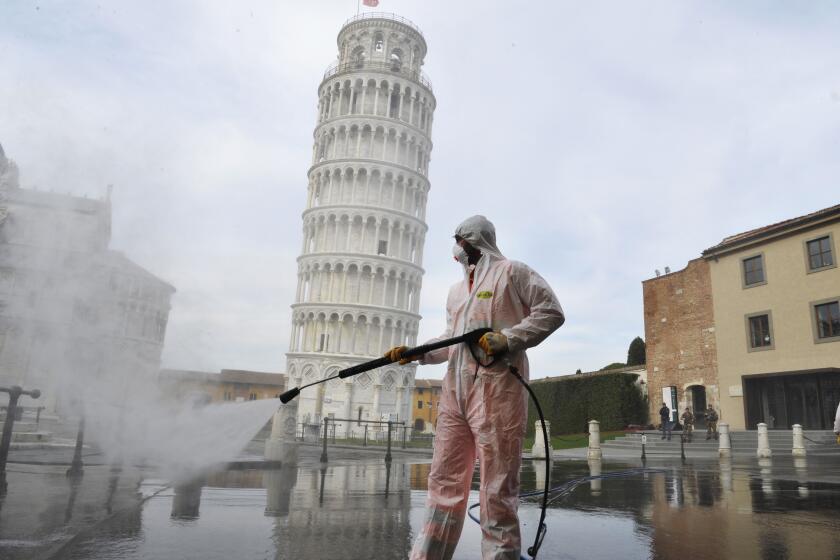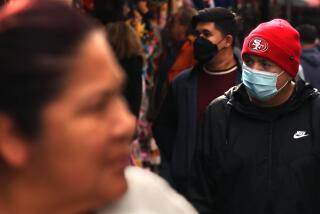Nearly half of all patients at one Kaiser hospital believed to have coronavirus
- Share via
MILLBRAE, Calif. — About half of Kaiser Permanente’s San Jose hospital has been filled with patients confirmed or suspected to have the new coronavirus, a hospital vice president said in an interview with a medical journal.
There have been so many patients that Kaiser San Jose has had to boost its staffing, Dr. Stephen Parodi, a Kaiser executive vice president, infectious disease expert and incident commander for the health system’s COVID-19 response nationally, told the Journal of the American Medical Assn.
“Our San Jose facility in California actually has almost half of the hospital filled either with COVID-confirmed or persons under investigation,” Parodi told JAMA. “So we’ve literally had to revamp the hospital to make sure that we’ve got enough capacity from a personnel standpoint. Because to provide the care to these patients requires resource intensive personnel.”
Silicon Valley has been one of the areas hardest hit by COVID-19. As of Tuesday, Santa Clara County had the highest numbers of deaths of any county in California, with 16 fatalities. The county reported 375 cases, second to Los Angeles County, which has 662 cases.
Kaiser, based in Oakland, cares for 12 million patients, operating 39 hospitals and 706 medical offices across the country, with facilities in Oregon, Washington state, Hawaii, Colorado, Georgia, Washington, D.C., Virginia and Maryland.
Parodi was unavailable for a followup interview earlier this week. Here are the key points of what he told JAMA on Friday:
The drivers of Santa Clara County’s economy — tech companies, foreign travel and close human interaction — made it a ripe target for the coronavirus.
Younger adults also unable to breathe on their own
It’s not just the elderly who have deteriorated clinically, Parodi said; it’s also younger adults who are unable to breathe on their own and require being placed on a mechanical ventilator, in which a tube is placed into the throat of a patient so the machine can push oxygen directly into the lungs.
“I think the jury’s still out about who is actually going to end up being the cohort that ends up in the hospitals. We have people that are as young as in their 30s and 40s who have clinically deteriorated and required mechanical ventilation,” Parodi said.
“There is, of course, the other cohort, the older cohort, in their 80s and 70s that are also in our ICUs,” Parodi said.
Big increases in coronavirus positive tests in NorCal and Washington
Kaiser has been seeing significant increases in the number of patients confirmed positive in its hospitals, particularly in Washington state and Northern California. “Those appear to be the current hot spot,” Parodi said.
The number of calls Kaiser is receiving from patients complaining of cold-like symptoms has been rising dramatically. Typically, at this time of year, Kaiser gets about 4,000 calls daily complaining of cough and cold; on Friday, they were getting 14,000 to 15,000 calls a day.
And that comes as positive flu tests have been significantly dropping.
“That tells me we’ve got COVID circulating. I can’t tell you what percentage of those calls are actually COVID positive. But I can tell you that this is the most calls we’ve ever gotten, period, writ large, over the last 10 years that I’ve been following the data,” Parodi said.
The latest maps and charts on the spread of COVID-19 in California.
An intensive care unit just for COVID patients
“Essentially we have filled one entire ICU just with COVID patients, which means that we have had to repurpose another unit to take care of the regular ICU patients as well,” Parodi said.
Of Kaiser’s two hospitals in Santa Clara County — San Jose and Santa Clara — “about a quarter of the patients are in the ICU relative to the others that are not,” Parodi said.
A two-week stay in the ICU
Once in the ICU, patients typically need somewhere between 10 to 14 days of mechanical ventilation, Parodi said.
“So this is a long-term proposition, in terms of vent days, ICU days and personnel days,” he said. “And I am concerned about planning for having enough ventilators — I’m talking about across the country — to be able to have this level of response.”
Preparing for a sudden surge in ICU patients
There can be a sudden increase in intensive care patients. “This thing can come on very quickly. So when you go from zero to having 10 patients — that happened for us ... in the ICU within one week,” Parodi said. “So you’ve got to be prepared for that level of surge.”
Planning for running out of ventilators
That means planning for an unthinkable situation, where the hospital may have to choose who gets a ventilator and who doesn’t.
The experience in Italy suggests that the hospital would have to do mass triage, and determine “who are the best patients that need mechanical ventilation, who are the patients that may not benefit from it.”
More than 3,000 cases of coronavirus infection have been confirmed in California and 67 people have died of COVID-19. Will the state be the next Italy?
A sudden deterioration after a week of mild illness
Some of those who end up in the intensive care unit actually come in as outpatients a week earlier before they need ICU care, Parodi said.
“They were relatively doing well,” Parodi said. “They had a cold and cough. And then they rapidly deteriorated the second week.”
The deterioration can be rapid — within hours. And patients suffering from difficulty breathing can suddenly need a breathing tube inserted into their throat and need to be hooked up to a mechanical ventilator to push oxygen into their lungs.
Slow coronavirus tests
Current testing is a slow. Most areas across the country are still limited by manual testing, Parodi said. Depending on the state you’re in, it can take one to two days before a test for an in-patient test result to come back, and five days or longer for an outpatient.
How to deal with N95 mask shortages
To deal with the national shortage of tightly fitting N95 masks, also known as respirators, that are designed to filter out 95% of airborne particles, Kaiser is moving toward reusing them, and getting some from a national strategic stockpile, some of which have expired.
N95 masks are particularly important when healthcare workers do procedures that aerosolize a patient’s saliva into tiny airborne particles that can float in the air, which happens when a breathing tube is inserted down a throat to hook up the patient to a mechanical ventilator to help them breathe when they can no longer do so.
Kaiser’s cancellation of elective surgeries earlier in March is also helping preserve masks and other personal protective equipment. Doing so has reduced the number of patients in the hospital by 15%, Parodi said, and instead of having just five to 10 days on hand of personal protective equipment, that’s increased to more than 30 days of supply.
Kaiser is also resorting to unorthodox measures — “literally going to hardware stores” to pick up personal protective equipment and finding “different vendors local to us to be able to provide masks and literally surgical masks, sewing them together, [and] getting the face shields made from hardware store material.”
More to Read
Sign up for Essential California
The most important California stories and recommendations in your inbox every morning.
You may occasionally receive promotional content from the Los Angeles Times.















